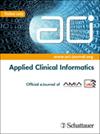User-Centered Design and Implementation of an Interoperable FHIR Application for Pediatric Pneumonia Prognostication in a Randomized Trial.
IF 2.1
2区 医学
Q4 MEDICAL INFORMATICS
引用次数: 0
Abstract
OBJECTIVE To support a pragmatic, electronic health record (EHR)-based randomized controlled trial, we applied user-centered design (UCD) principles, evidence-based risk communication strategies, and interoperable software architecture to design, test, and deploy a prognostic tool for children in emergency departments (EDs) with pneumonia. METHODS Risk for severe in-hospital outcomes was estimated using a validated ordinal logistic regression model to classify pneumonia severity. To render the results usable for ED clinicians, we created an integrated SMART on FHIR web application built for interoperable use in two pediatric EDs using different EHR vendors: Epic and Cerner. We followed a UCD framework, including problem analysis and user research, conceptual design and early prototyping, user interface development, formative evaluation, and post-deployment summative evaluation. RESULTS Problem analysis and user research from 39 clinicians and nurses revealed user preferences for risk aversion, accessibility, and timing of risk communication. Early prototyping and iterative design incorporated evidence-based design principles, including numeracy, risk framing, and best-practice visualization techniques. After rigorous unit and end-to-end testing, the application was successfully deployed in both EDs, which facilitatd enrollment, randomization, model visualization, data capture, and reporting for trial purposes. CONCLUSIONS The successful implementation of a custom application for pneumonia prognosis and clinical trial support in two health systems on different EHRs demonstrates the importance of UCD, adherence to modern clinical data standards, and rigorous testing. Key lessons included the need for understanding users' real-world needs, regular knowledge management, application maintenance, and the recognition that FHIR applications require careful configuration for interoperability.以用户为中心设计和实施可互操作的 FHIR 应用程序,用于随机试验中的儿科肺炎诊断。
目的为了支持基于电子健康记录 (EHR) 的随机对照试验,我们应用以用户为中心的设计 (UCD) 原则、循证风险交流策略和可互操作的软件架构,为急诊科 (ED) 中的肺炎患儿设计、测试和部署了一种预后工具。为了让急诊科临床医生能够使用这些结果,我们创建了一个集成的 SMART on FHIR 网络应用程序,该程序可在两家使用不同 EHR 供应商的儿科急诊科进行互操作使用:Epic和Cerner。我们采用了 UCD 框架,包括问题分析和用户研究、概念设计和早期原型开发、用户界面开发、形成性评估和部署后总结性评估。结果来自 39 名临床医生和护士的问题分析和用户研究显示,用户偏好风险规避、可及性和风险交流的时机。早期原型设计和迭代设计采用了循证设计原则,包括数字、风险框架和最佳可视化技术。经过严格的单元测试和端到端测试后,该应用程序在两个急诊室都得到了成功部署,为试验目的的注册、随机化、模型可视化、数据采集和报告提供了便利。主要经验包括需要了解用户的实际需求、定期知识管理、应用程序维护,以及认识到 FHIR 应用程序需要精心配置以实现互操作性。
本文章由计算机程序翻译,如有差异,请以英文原文为准。
求助全文
约1分钟内获得全文
求助全文
来源期刊

Applied Clinical Informatics
MEDICAL INFORMATICS-
CiteScore
4.60
自引率
24.10%
发文量
132
期刊介绍:
ACI is the third Schattauer journal dealing with biomedical and health informatics. It perfectly complements our other journals Öffnet internen Link im aktuellen FensterMethods of Information in Medicine and the Öffnet internen Link im aktuellen FensterYearbook of Medical Informatics. The Yearbook of Medical Informatics being the “Milestone” or state-of-the-art journal and Methods of Information in Medicine being the “Science and Research” journal of IMIA, ACI intends to be the “Practical” journal of IMIA.
 求助内容:
求助内容: 应助结果提醒方式:
应助结果提醒方式:


